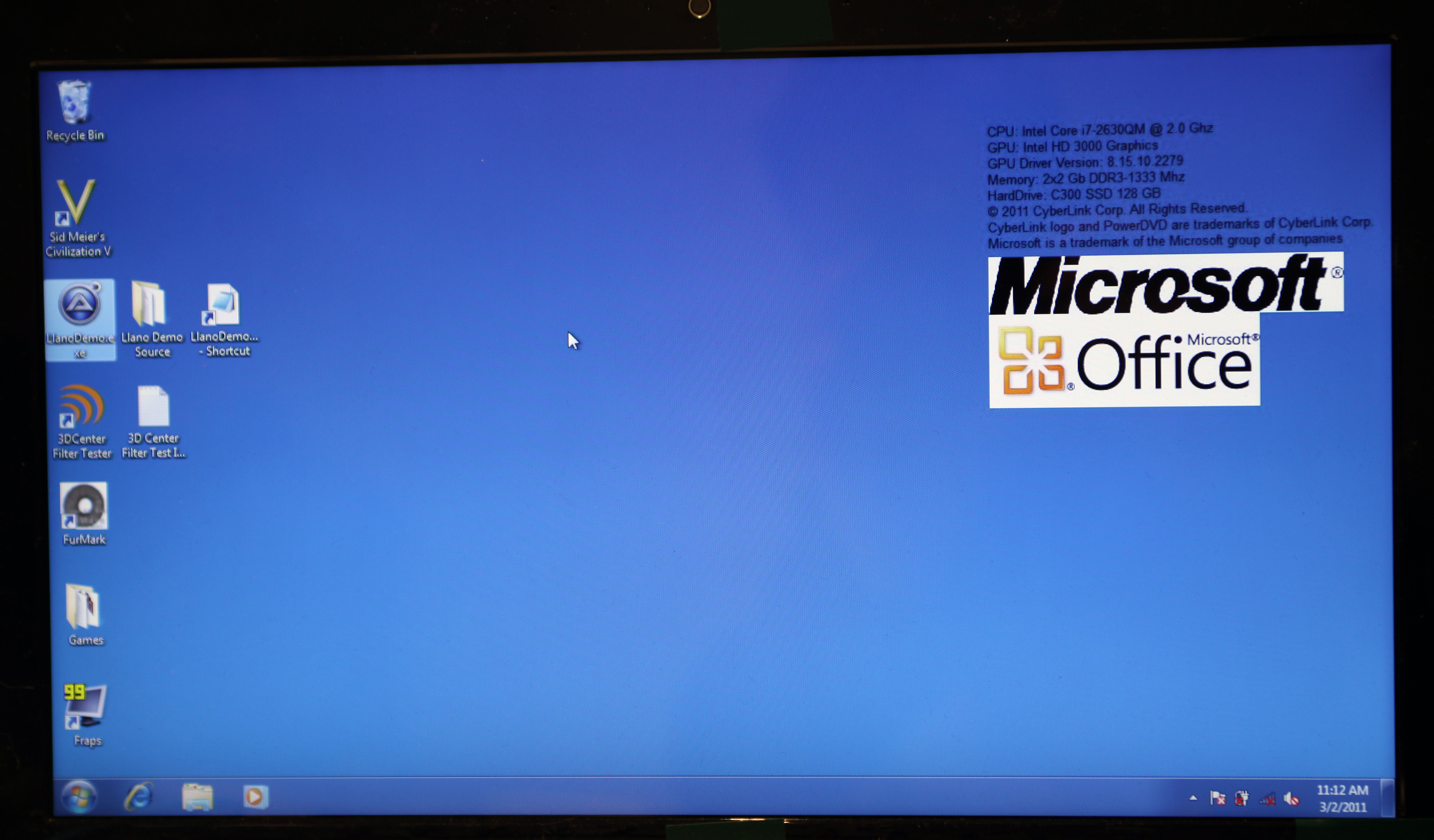CeBIT 2011: AMD Demos Llano Behind Closed Doors
Apparently, Fusion technology demos behind closed doors are becoming an AMD tradition. At this year's CeBIT, the chip maker demoed its upcoming (and highly-anticipated) Llano APU. Naturally, the Tom's Hardware team was on-hand to take a closer look.
AMD Shows Off APU Power And Performance
The final test was meant to put performance and power consumption in perspective. Step one was to establish a baseline by looking at idle power. The Intel system was sitting at about 12.5 W, while the AMD machine was more power-hungry at 26 W. John was quick to remind us that this was not a final product, and that power should come down significantly with BIOS tweaks and other improvements (though we're honestly not sure how much more AMD can cut power so close to launch).
For this part of the presentation, AMD used a script that added a workload each time the return key was pressed. Workload number one was the Final Fantasy XIV benchmark, workload two an Excel spreadsheet with automated calculations, number three consisted of a 1080p video (Big Buck Bunny), and workload four had SPECviewperf rendering the wireframe model of a car. The final step was to use Windows 7’s Flip 3D to cycle through these programs.


Starting out, the Llano system was running pretty smoothly and drawing about 52 W in Final Fantasy XIV, while the Core i7 was closer to 61 W with frequent dips to 44 W. Why the dips? This happened whenever the integrated graphics engine was no longer keeping up with rendering, basically going idle, then getting back to work. Adding the Excel spreadsheet caused power consumption to climb to about 54 W on the Llano-based machine, pushing Sandy Bridge to between 52 and 68 W (with the pronounced dips, again). However, as soon as Excel was the top window, the frame rate in Final Fantasy tanked even more (because the system was having a hard time prioritizing the tasks, as John explained). Conversely, bringing the game benchmark to the front caused Excel to slow down. The same didn’t apply to Llano.


Playback of the 1080p video using CyberLink’s PowerDVD 10 did nothing to AMD's power consumption, which hung steady at around 54 W. Sandy Bridge, on the other hand, was now up to 70 W and stuttering in the two other workloads. The video remained smooth throughout, though.
Finally, SPECviewperf caused the Llano system to top out at 55.5 W, while Sandy Bridge plateaued at 70 W. However, both the game benchmark and SPECviewperf were basically reduced to slide shows on the Intel platform. AMD’s system wasn’t as fast as it had started out, but was still definitely smoother on all workloads.


Less of an objective yardstick, but definitely interesting as well, was the final twist AMD put on this part of the demo. With all four workloads chugging along, the script then told Windows 7 to use Flip 3D to cycle through application windows after a certain amount of work had been completed. The result here follows the pattern established above: during the time Intel's system managed to “flip” once, Llano did so three times, looking much smoother while doing it, too.
The point to take away here, according to AMD, is that benchmarks focusing on a specific component like the CPU or GPU, will be less relevant with parallel workloads and highly integrated processors like Llano. It won’t matter as much if one system is 20 percent faster in one specific benchmark running on its own because the user will be doing many things in parallel. And when it comes to juggling GPU and CPU workloads, an APU does better. Stepping back, we'd agree, with caveats. But the extent to which AMD's demo might map to the real-world is also fairly unrealistic, too. This is of course something we'll keep in mind for benchmarking moving forward, and if you want to share some of your own multi-tasked workloads with us in the comments section, we'd be glad to put together real-world examples of testing these parts running concurrent metrics.
Get Tom's Hardware's best news and in-depth reviews, straight to your inbox.
Asked about the time frame for the introduction of the A-series parts currently known as Llano, John said they would be shipping between May and July, hinting very strongly that we should expect to see a launch sometime around June. Or maybe that was just our interpretation. At any rate, we were shown one more interesting demo from AMD to showcase the strengths of the Fusion architecture and specifically its Llano APUs.
-
amk09 APU's are cool especially for cheap mobile gaming but I'm still looking forward to the more powerful CPU's AMD will be offering WITHOUT integrated graphics.Reply -
Cool, me i encode a lot.. so what about ENCODING... with handbrake ?! can't wait to see the results.Reply
gj AMD... i was losing hope but its back now! -
sabot00 Seems to be pretty good, but the price matters dramatically, for a $600-700 laptop this would be very good performance, but if the Phenom cores have not changed much then the clock speed really does need to go up to say 2.4GHz at least, with 2.8GHz+ being more ideal.Reply
For a quad-core 2 GHz will probably be OK, but not that many applications really benefit, and for multitasking AMD will need to pull through with the software.
For the GPU, I would say 200SP's should be the minimum, and from the HD 3000 to Llano comparison I would peg the GPU at that. At 200 SP's it would be very decent for mainstream gaming at lower resolutions, playing most games quite smoothly at low-mid settings. However Llano could take a larger and higher chunk out if it gets a few versions with 300 or 400SP's.
All-in-all, this current 4 core, 1.8GHz, ~200SP version is very respectable and has a lot of potential, but AMD needs marketing, deals with OEMs, and more marketing.
What would I prefer? A 2 core, 2.6Ghz over this CPU, and maybe just a bit more SP's.
Oh! And overclocking support. -
epdark In regards to your guys request for information about how we are using our systems. I am probably a horrible case...Reply
I almost always choose to run games in windowed mode (FFXIV for example) and am often surfing the fan sites, youtube, etc while I am also running the game in the background and quickly switching back and forth. I've also began using Office to write papers at the same time and as well sometimes have a 1080p or 720p movie playing pinned to top while I'm doing so...
So yes, those sort of uses are growing increasingly appealing to me. I find that we don't even realize it sometimes but as the technology allows we are beginning to multitask with it in a natural and almost unconscious manner.
I don't do those things because I know I can and I should. I do those things because I now can and they seem natural progressions for my usage. -
cangelini I'm with you epdark. Even when I'm playing WoW, I'm often looking at YouTube to research upcoming fights and WoWwiki for info on various abilities. You're not a horrible case at all :)Reply
Chris -
bugo30 I sometimes render an animation in Blender, listen to music, have Firefox open on one monitor and a full screen game open on the other. This doesn't work very well on my Athlon X2 4800. I'd be interested to see how it would work on a modern CPU.Reply -
drakefyre What does Quick Sync do for HD vid playback? Shouldn't it almost eliminate processor and graphics workload, or do I misunderstand it?Reply -
joytech22 I normally play RS in resizeable mode while watching youtube video's, RS is very CPU-intensive (Grand Exchange) as well as quite graphics hungry in some areas.Reply
GPU does the rendering (RS graphics and Youtube video processing) while the CPU cores also do rendering for RS, as well as animation processing.
Can be quite taxing on a system, especially my laptop with a Radeon 4530 and a C2D 2.2GHz. -
dmytty Idle power consumption is once again dominated by Intel...why?Reply
My priorities for laptops are such:
1. As light and durable as possible for the given size
2. Good Screen (non-glossy, high resolution, outdoor viewable, high gamut)
3. Long battery life - 8 hrs seems a reasonable compromise
If I'm doing something resource-intensive, I'll sit behind a desktop.
Given that most multi-tasking still results in an idle state most of the time, I can't see how AMD is competitive on point #3 while having double the idle power consumption of Intel.
2x more idle?...AMD is really doing something wrong.

